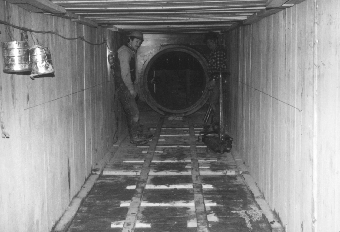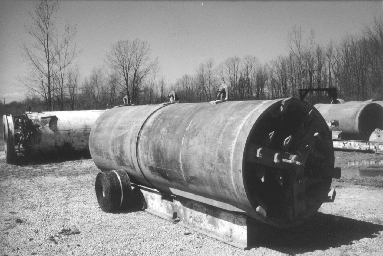 |
 |
| Remember When . . . |
Tunnel Work
by Charlie Fecteau, Laborers' Local #113
 |
 |
| Above Left - In 1975, two miners and two muckers, mined this Wisconsin Electric steam tunnel by hand. Right - A laborer-operated 42-inch mining machine, has replaced much of hand-mining today. |
Regardless of industry, Laborers work has changed quite a bit over the years. This is especially true with tunnel work where, over the years, more and more of the work has become automated and with each technical advance the number of laborers needed on projects continues to decline. As recently as the early 1970's most mining had to be done completely by hand and at times under compressed air conditions. In those days tunneling meant four guys — two miners and two muckers — working on their knees with air-spades, shovels and muck cars, removing the muck and setting the lumber. Then, tunneling 10 feet in eight hours was a good day and that didn't count having to come back after the mining was completed to lay the pipe and backfill. The last compressed-air project in the Milwaukee area was completed in 1985 with Tomaro Contractors. Today, a mining machine can tunnel and place 100 feet of pipe in a day as finished product. A conveyor moves the muck into the cars continuously out of the shaft, with 7 to 8-foot pipe jacked into the tunnel with each advance of the machine. Work that had once been done under compressed air — conditions that have permanently cripple many laborers — has been replaced with an earth-balanced machine. Today, these machines can handle most any wet-ground conditions. But, for all the new technology, mining itself — working deep under ground in a very confined space for eight or more hours a day — hasn't changed much over the years. Laborers are still in control of running the equipment, and like most laborers work it is very hard and extremely dangerous. Mining machines allow 42 inches of clearance to the laborer at its controls, in shafts often times hundreds of feet long and deep. The conveyor that moves the muck out of the shaft runs directly above the operator's lap. A small opening in the front of the machine, that is supposed to close immediately during a cave-in, allows the laborer access to the jacking for maintenance or for blasting. Every time a pipe comes in, the power is shut off, so the laborer sits literally in the dark until the section of pipe is placed. In addition to having a laborer at the controls in the tunnel, there are now remote controlled slurry machines that allow laborers to control the mining from above ground and to view the operation through fiber optic cameras. Two set pipe in the shaft and they get up to a pipe an hour. Nevertheless, newer technology cannot handle every situation under ground. Even today mining and clearing still goes on by hand, with miners and muckers spending their days laying pipe in the cramped four-foot by four-foot shafts they've constructed. |